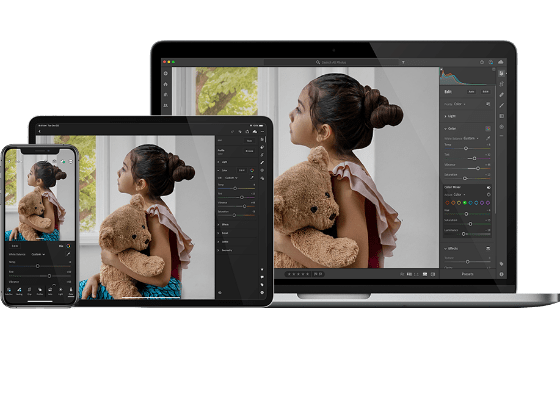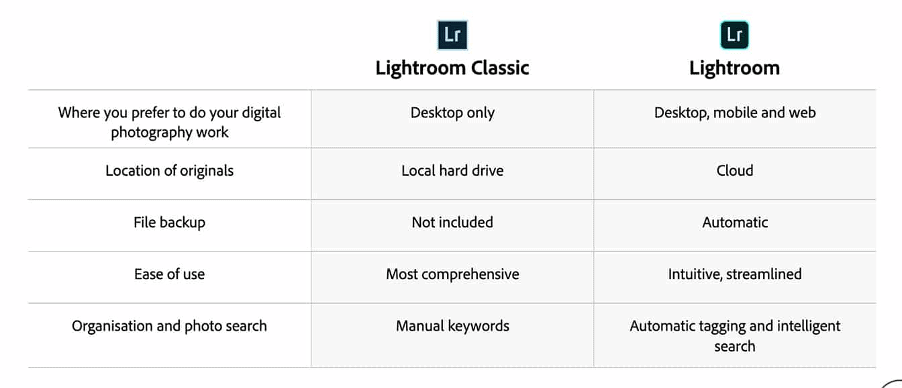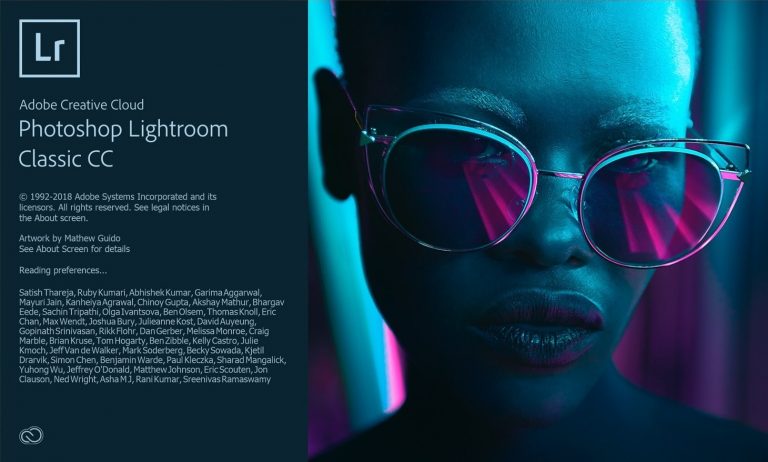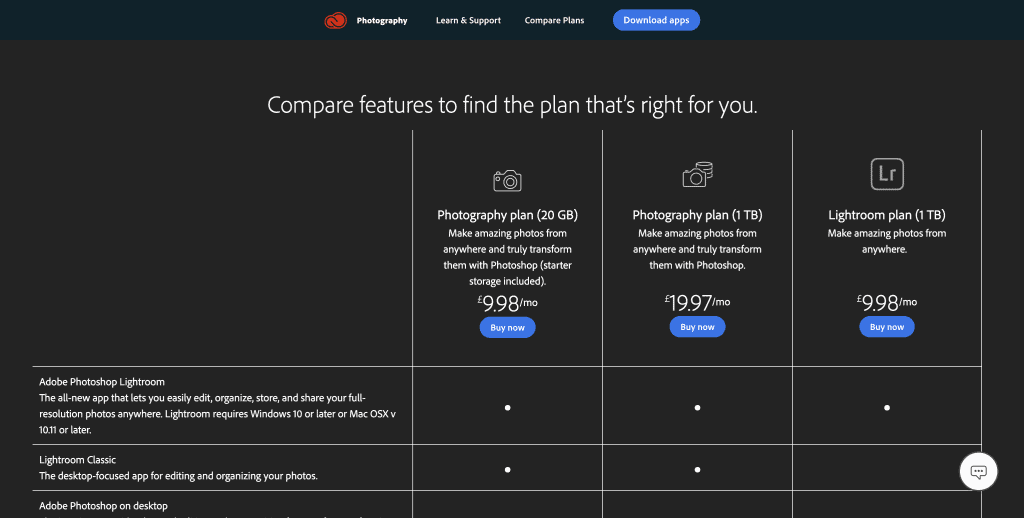Introduction
I thought it might be useful to write a review of Adobe Lightroom Classic. This article is for beginners, amateurs and enthusiast photographers. I’m pretty sure if you’re professional you’ll already be using it and will be reading something else!!
I’ve been using Adobe Lightroom Classic for many years now since I moved across from Apple’s Aperture which was discontinued around 2012 and even though it is only available on a subscriptions basis I always recommend it to new photographers or those looking to change or get into photo editing.
I appreciate that a subscription based software is large commitment especially for a beginner or enthusiast photographers who do not earn money from there photography, however, it is an investment your photography and the cost of the Photography plan per month is approximately what you would have been paying for a roll of 36 exposure film and the developing and printing of that roll back in the mid 1990’s.
This review will help you decide whether you need Adobe Lightroom Classic to edit and organise your photos in 2020 and beyond.
What is Adobe Photoshop Lightroom Classic?
Adobe Photoshop Lightroom Classic is a desktop-focused RAW image editor. Within the photographic community often simply called ‘Lightroom’ and as touched on it requires a subscription to the Adobe Creative Cloud, most commonly most enthusiast photographers use the Photography Plan.
Lightroom Classic allows you to organise, edit, print and share your photos. Record where they were taken on a Map, collate images to a Book, create a SlideShow and create a basic Web gallery
A Lightroom Classic subscription also gives you access to Adobes famous Photoshop and Lightroom (aka Lightroom CC/Mobile), which is web-based image editor.
There can be confusion between Lightroom Classic and Lightroom, the key difference between them is that Lightroom classic stores your RAW images locally on your computers hard drives were as Lightroom stores the RAW images in the cloud. While they are both RAW editors but there are a few differences between them and while this article concentrates on Lightroom Classic please see my article on how to integrate them both together to supercharge your editing workflow.
As well as RAW files Lightroom can also edit JPG, DNG, TIFF, PSD, CMYK, PNG, PSB & video files.
Image editing is performed via a range of sliders and buttons, and is entirely non-destructive (i.e. you can return to any edited or unedited state of your original file at any time). You can create or add from other sources Presets or Creative Profiles to Lightroom to speed up photo edits.
Lightroom Classic is extremely simple to pick up, and is a simple or as complex as you want to be.
System Requirements

Minimum Windows Requirements
- Processor: Intel® or AMD processor with 64-bit support; 2 GHz or faster processor
- Operating system: Microsoft Windows 10 with 64-bit support (Version 1803 or later)
- RAM: 4 GB of RAM (8 GB recommended)
- Hard disk space: 2 GB of available hard-disk space for program installation
- Monitor resolution: 1024 x 768 display
- Graphics processor acceleration requirements: AMD: Radeon GPU with DirectX 12 support.
- Intel: Skylake or newer GPU with DirectX 12 support.
- NVIDIA: GPU with DirectX 12 support.
- 1 GB Video RAM (VRAM). 2 GB of dedicated VRAM (4 GB recommended) for large, high-resolution monitors, such as 4K- and 5K-resolution monitors.
Minimum Mac Requirements
- Processor: Multicore Intel processor with 64-bit support
- Operating system: macOS v10.13 or later
- RAM: 4 GB of RAM (8 GB recommended)
- Hard disk space: 2 GB of available hard-disk space
- Graphics processor acceleration requirements: AMD: macOS 10.13 or later with Metal support.
- Intel: macOS 10.13 or later with Metal support.
- NVIDIA: macOS 10.13 or later with Metal support.
- 1 GB Video RAM (VRAM). 2 GB of dedicated VRAM (4 GB recommended) for large, high-resolution monitors, such as 4K- and 5K-resolution monitors.
Importing Photos into Lightroom Classic
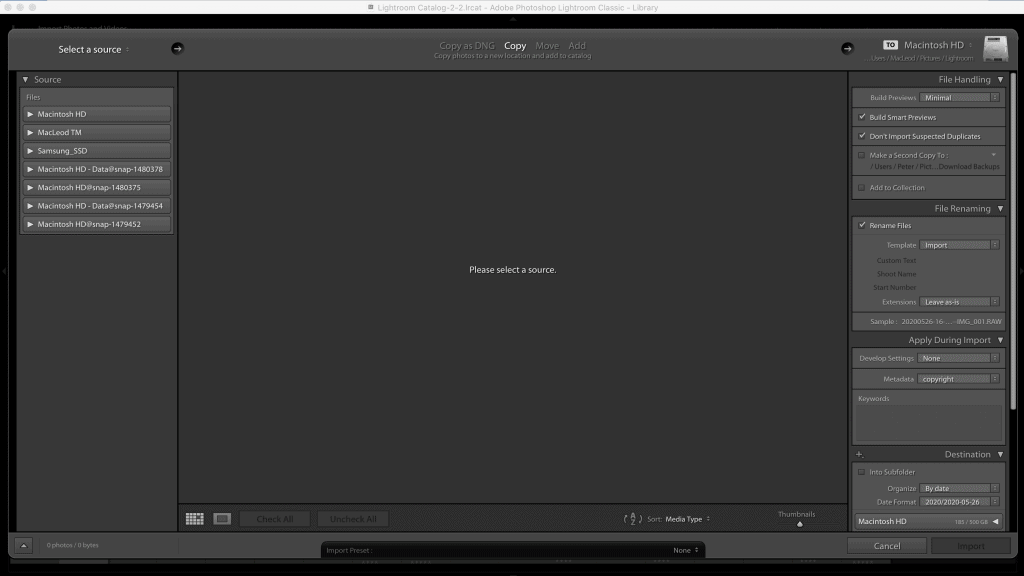
After the initial installation of Adobe Lightroom Classic, the next step is getting your photos into the Library module for organisation and proofing. Lightroom imports images into a Catalog, which establishes a link between the Catalog and the physical file.
This Catalog can be stored separately to your image files meaning you can store your images on external drives I would recommend SSD drives for the images you are currently working or a NAS (Network Attached Storage).
At import, you can choose to Copy, Copy as DNG (Adobe’s own open-source RAW file format), Move or Add your images, depending on how you plan to store them.
Copy & Copy as DNG are usually used when you are bringing images off your Camera’s Memory card, Move is for images that are already on your computer or a drive but you want Lightroom to store in a different place and Add is for images that are already on a drive you don’t want the moved you just want Lightroom to be able to find them.
You can create Previews of various sizes during import, which helps speed up subsequent viewing/editing within Lightroom. You should also build one of Lightroom Classics best advantages Smart Previews.
Smart Previews are a smaller file that sits alongside your catalogue and allows you to edit images when the corresponding RAW file is not physically connected to your computer. e.g. you can leave your external hard drive at home when you head to the coffee shop to a bit of editing.
Also if you’re using an older computer working with Smart Previews instead direct from the RAW file can allow much faster editing, while still retaining all the benefits of RAW editing.
At import, you can also choose to Ignore Duplicates (very useful if like me you forget to format your cards), Add to a Collection (a kind of virtual folder), Make a Second Copy to another location, rename files, add Keywords and Meta Data, and add Develop Settings i.e. Presets.
Lightroom Presets are a popular way of saving time during the photo editing process, by applying certain ‘looks’ to images – whether ones you’ve created yourself or have acquired elsewhere, there many free presets out there and many photographers sell there own presets too.
Applying Presets at the import stage is simple and enormously efficient, especially when editing large quantities of images.
Organising Photos in Lightroom Classic (Library Module)
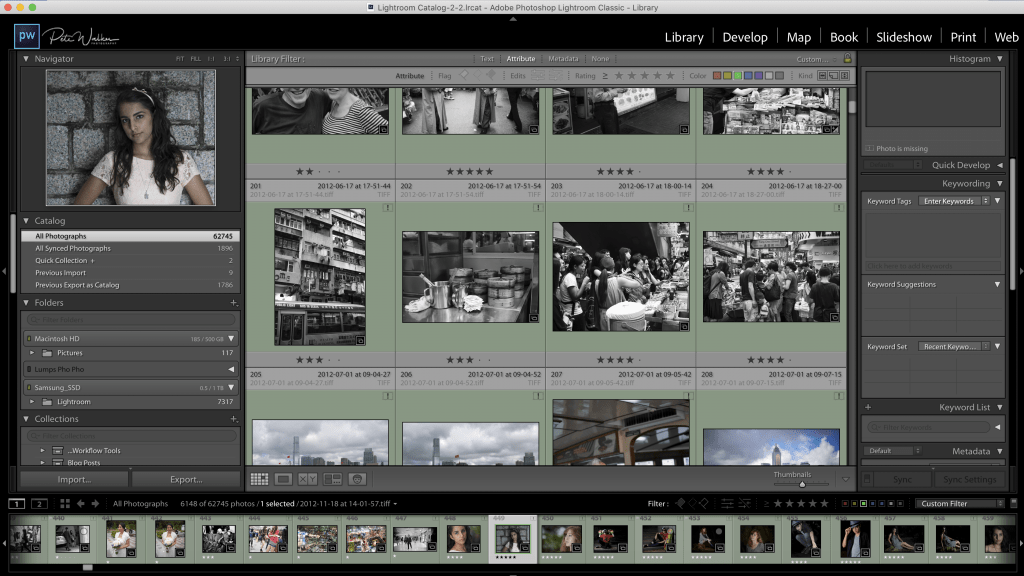
Photos imported into Lightroom Classic can be found in up to 3 locations – Catalog, Folders and Collections, all of which reside in a panel on the left of the Library Module.
The Catalog shows every photo that exists in Lightroom as well as various filtered views.
Folders show your computer’s folder hierarchy, based on any images that have been imported.
Collections are like virtual folders, which allow you to create groups of images without affecting their actual location on your computer’s hard drive.
Smart Collections obey various ‘rules’, automatically organising your photos based on star ratings, colours, or other criteria. These can be a useful way to group particular images.
Anything deleted from a Collection remains inside your Lightroom Catalog.
Anything deleted from your Catalog will be deleted from either your Catalog only, or from your Catalog and your hard drive depending on the option you choose.
It certainly takes some getting used to, but it’s a logical way to handle large volumes of photos, especially if files are scattered across your internal and external hard drives.
One of the biggest advantages of the Collections in the Library module is the ability to sync them with Lightroom CC (i.e. the web-based application) and all your smart devices, just by clicking a tiny bi-directional arrow icon next to your Collection.
Synced Collections, automatically update with any photos you add or remove or any edits you make on the original computer or any of your devices.
I’ll talk more about the web-based version of Lightroom (aka Lightroom Mobile or CC) in a different article to try to avoid confusion that caused by Adobe creating software practical identical names. Especially as the differences between the 2 versions are subtle but very important.
The Library module is the quickest way to view larger versions of each image thumbnail. Used in conjunction with Smart Previews, viewing is lightning fast, even with thousands of images.
You can filter your images using various criteria, including flags, ratings, colour labels, exif data (ISO, Shutter Speed, Aperture, etc) and even what camera or lens was used to take the photo.You have the ability to add keywords.
Keywording photos is a powerful tool but is obviously only effective if you take the time to do it. Done correctly, it’ll allow you to find that needle in a haystack…
Developing Photos in Lightroom Classic (Develop Module)
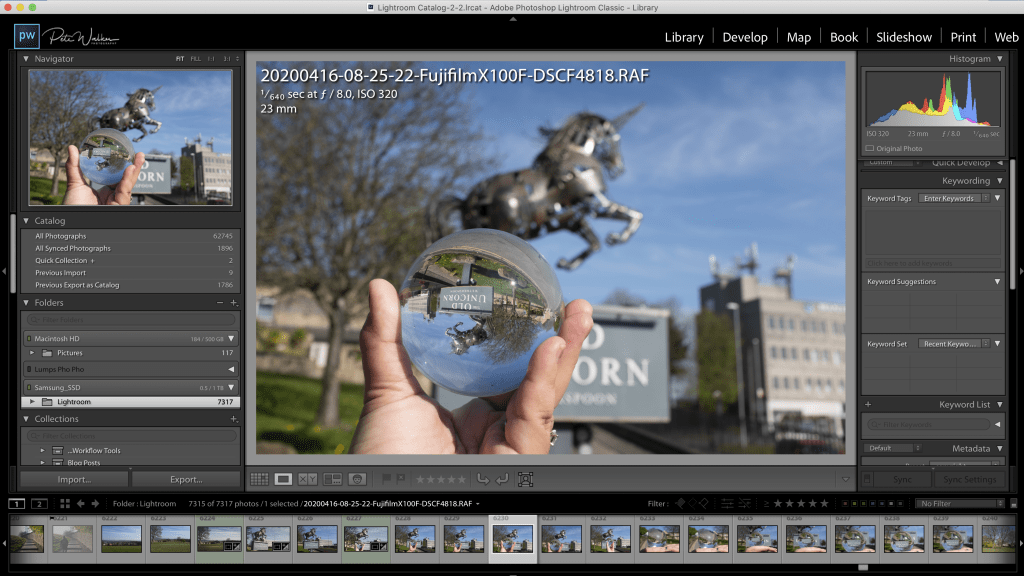
Lightroom Classic offers a suite of editing tools in its Develop module, which will allow you to get the absolute most out of all the available Data in your cameras RAW files.
You can use the tools to edit JPEGs or any of the aforementioned file types, but it’s in the editing of camera RAW files where you’ll see the most difference in your images.
Basic Editing Tools in the Lightroom interface include:
- Treatment– colour or black and white
- Profile– Adobe RAW profiles: Colour, Monochrome, Portrait, Landscape, Neutral & Vivid Plus access the profile offered some camera manufacturers e.g. Fuji
- Profile Browser– one-click Creative Profiles to give your photos a ‘look’
- White Balance– colour temperature
- Exposure– overall brightness
- Contrast– the contrast between darks and lights
- Highlights– bring out or reduce bright areas
- Shadows– darken or lighten shadow areas
- Whites– adjust the brightness of whites
- Blacks– adjust the darkness of blacks
- Texture– smooth or enhance textures without losing finer details
- Clarity– enhance the mid-tones to increase texture and sharpness
- Dehaze– enhance or remove the hazy effect created by sun or fog
- Vibrance– adjust the brightness of colours
- Saturation– increase or decrease colour saturation
Dehaze and Texture have bee introduced relatively recently in Lightroom updates and are powerful tools that don’t exist in other image editors. Adobe is constantly developing Lightroom and these updates are included with your Adobe Creative Cloud subscription.
If you’re just getting started with editing RAW images, you’ll spend most of the time in the Basic panel, where sliding the sliders will bring immediate changes to your photos.
One of the best ways to learn Lightroom is by experimentation, and fortunately, this is made easy and ‘safe’ as all edits are reversible, using the Undo function, or via the History panel which allows you to pinpoint a past edit.
In addition, you can create Virtual Copies of any image, which allows you to experiment with editing to your heart’s content, then create multiple versions of the same image.
Virtual Copies do not affect your original image– you’re simply creating virtual ‘replicas’ of the image, solely in Lightroom – and allows you to easily compare multiple edits and they don’t take up valuable Hard Drive space.
Moving down on the right side of the Develop module, we have:
- Tone Curve– increase or decrease contrast and brightness
- HSL/Color– adjust the Hue, Saturation and Luminance of all the various colours
- Split Toning– add different colour tints to shadows and highlights
- Detail– add sharpness and reduce noise to bring out finer details
- Lens Corrections– automatically fix lens issues like distortion, chromatic aberration and vignetting
- Transform– adjust perspectives, straighten horizons
- Effects– add vignetting and film grain effects
- Calibration– fine-tune the colour profile that’s calibrated to your camera
On the left side of the Develop module, you can access your Presets, History and Collections.
Above the Basic panel lives the Selective Editing Tools, allowing you to make more precise edits to specific areas of your photos.
- Crop– straighten and crop your image
- Spot Removal– remove small unwanted details (e.g. blemishes on the skin)
- Red-Eye Correction– automatically correct red-eye
- Graduated Filter– digitally apply the effect of a graduated neutral density filter
- Radial Filter – apply local adjustments to a specific, circular area
- Adjustment/Healing Brush– apply local adjustments by painting them onto specific areas
There’s also a histogram, which allows you to make direct adjustments to shadows, exposure and highlights. It’s a great way to understand how a camera histogram works.
Each of the Develop module’s editing tools are powerful and useful in specific situations.
Do not be put off by the vast array of tools available, you do not need to use them all and certainly, you don’t need to use them all in one photo. If you speak to a range of Professional Photographers you find that they on average use about 50% of the available tools on a regular basis. Most amateur photographers will only access a fraction of the editing tools, but it’s nice to know everything’s there when it comes time to experiment further.
My typical editing workflow could involve the following:
- Import photos customre naming files to (YYYY-MM-DD-Hr-Min-Sec-CameraModel-Originalfilename)
- Separate ‘keepers’ into a Collection
View each image in the Develop module, apply preset for a specific look and adjust exposure etc. - Export using an export preset for use on Facebook etc
As with lots of software tools can be accessed quickly using keyboard shortcuts (you learn these over time) and changes made to photos are for the most part instantaneous.
There’s also a handy ‘Edit In’ feature, where ‘higher-level’ editing changes can be made using external editors you own, such as Photoshop or Nik Software while keeping the original image within Lightroom and not lost to depths of your Hard Drive.
Another powerful feature of the Develop module is the ability to make batch edits, using the Copy/Paste or Previous buttons.
Batch editing in Lightroom can be a huge time-saver, particularly if you’ve shot the same scene in similar lighting conditions, allowing you to make the same edit to multiple images at once, after a studio shoot for example.
Also aside from these core tools, there is a multitude of other useful features hidden away in menus for you to discover while experimenting.
Depending on the speed of your computer and how you have set up, some lagging can occur in the Develop module, particularly on images that require numerous edit. Using Smart Previews can help alleviate this to some extent, as will keeping your workflow efficient which it will with practice.
On the whole, though image editing using the Develop module in Lightroom Classic is, on the whole, a smooth, intuitive and enjoyable process. Using the various photo editing tools allows you to extract and manipulate the existing data in your RAW images, with various time-saving features accessible to all level of user.
Exporting Photos from Lightroom Classic
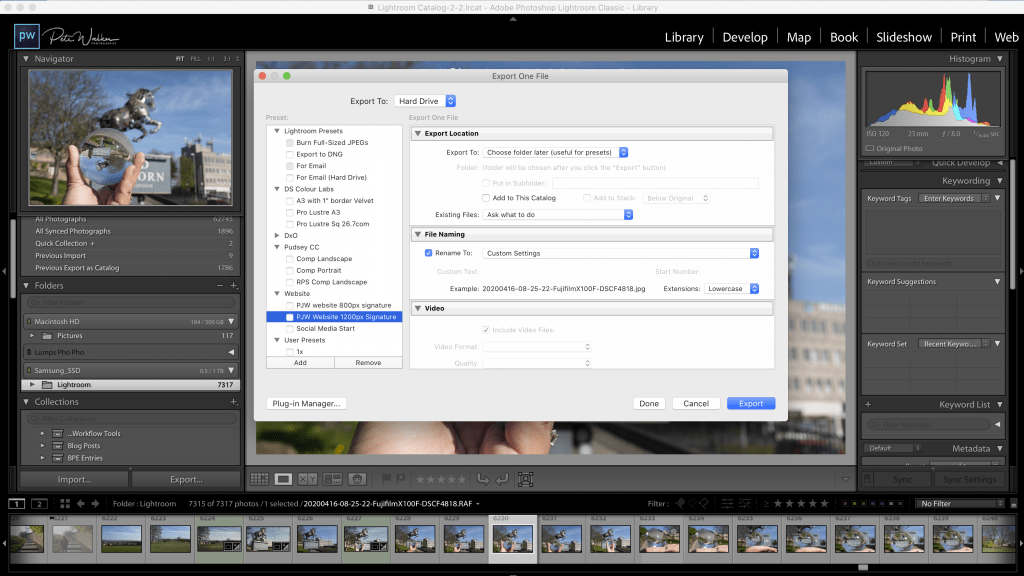
The Lightroom Classic Export function allows you to get your edited images out of Lightroom and onto your hard drive for use in social media, online galleries etc etc.
Options with Export include:
- Export Location– select where to save your files
- File Naming– choose how your files will be named
- File Settings– select desired image format, compression and colour profiles
- Image Sizing– set image resolution and choose whether to resize your images on export
- Output Sharpening– apply sharpening effects
- Metadata– select whether or not to include metadata in your images
- Watermarking– apply a pre-saved watermark
Being able to apply these final adjustments to your images in one automated swoop is a huge time-saver. In addition, creating Export Presets allows you to save commonly used export settings. A recent update, has allowed you to use multiple Export Presets simultaneously.
An example preset would be to apply resizing, sharpening, watermarking, then converting of your images to JPEG, for optimal sharing on Facebook.
Other features of Lightroom Classic
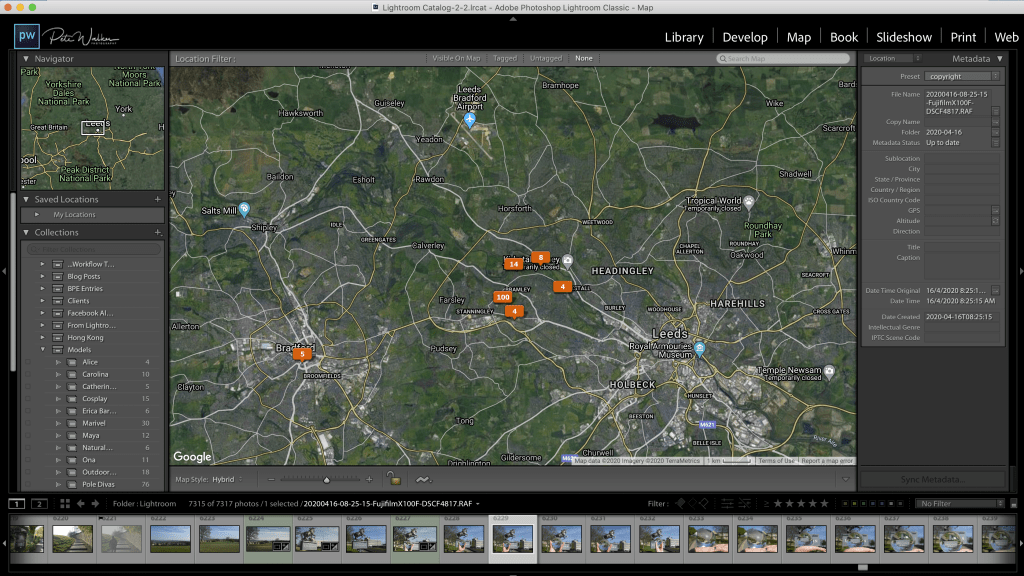
Most photographers spend their time editing and organising photos in the Library and Develop modules of Adobe Lightroom Classic.
However, there are 5 other modules that deserve a few words:
- Map– organise and view your photos by location using GPS data plotted onto a map
- Book– create a photo book or magazine layout
- Slideshow– create a slideshow with photos, text and transition effects
- Print– specify the page layout and print options for photos and contact sheets
- Web– create a website layout from your photos
Each of these functions can be useful depending on your needs.
If you do a lot of smartphone photography or your camera that automatically embeds GPS data to you images, the occasional glance at the Map module, which uses embedded GPS data from photos to plot their location on an embedded Google Map can be fun. You can also manually add images to the map which something I’m trying remember to do more.
The Print module is also convenient, when you want to create custom photo collage layouts, with most standard professional paper stock and sizes supported.
Overall Ease of Use
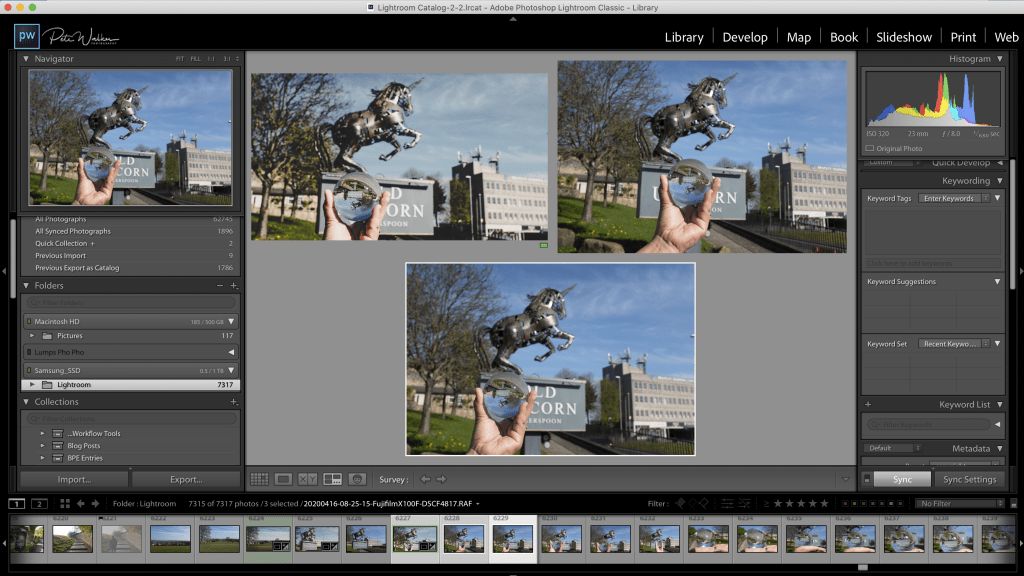
As we have talked about, new users of Adobe Lightroom may be confused initially about the difference between the desktop-focused application (aka ‘Classic’), and the web-focused application (simply called Lightroom).
The import process can also cause some head-scratching, with the difference between Copy, Move and Add not being immediately obvious.
Aside from this, the basic editing and organising of images using either version of Lightroom is on the whole intuitive, simple and fun.
Local adjustment tools and more advanced options do have a learning curve, but thanks to the age and popularity of the Lightroom, everything is well documented online YouTube is your friend.
Lightrooms WYSIWYG interface provides instant visual feedback of any image adjustments, with everything reversible, and the original file left intact (aka lossless editing).
Beginners should just dive in and experiment and as there confidence grows they can learn more and more. I don’t know everything about Lightroom because I don’t need to I just need to know what is required to process photographs to my liking.
Overall Performance
For the beginner, Amateur or Enthusiast photographer Lightroom Classics performance is more than adequate. As I touched on earlier As with all software, slow performance can be attributed to several factors, most of which have nothing to do with the software itself; therefore modern computer with plenty of RAM and preferably a SSD and will serve you best when running Lightroom, especially when editing large files. However, even with the fastest computer set up, there are still some operations will hit a speed bump.
The most common place to encounter a bump is, importing large numbers of images to your Lightroom Catalog which can is rather slow, especially if you’re creating Smart Previews and applying Develop Presets. However, be patient grab a coffee and go watch TV. If you are importing thousands and thousands it might be more than one coffee
It’s also difficult to start culling and editing images before the entire import process has finished. Many pros choose a standalone software like Photo Mechanic to import photos for this very reason, but as an enthusiat this probably not necessary.
Exporting images is a processor intensive process, with performance improving on computers with multiple cores, but again be patient
On the whole, with your computer and the application set up properly, performance is good enough for most of us. Remember using Smart Previews makes things much quicker, and every Adobe update brings about overall performance boosts.
Overall Value for Money
As I said into the introduction, a subscription-based software might seem to rather unpalatable until you look at in relation to the costs you would have been paying in the film days.
Also being a subscription you are always receiving the latest version of the software, when you make a one-off purchase there is a tendency to hold onto the software for 3 or 4 years before you upgrade.
Your subscription to Lightroom Classic gives you access to 7 powerful modules, with each one packed full of useful functions for everyone from beginners through to pros.
While I have just introduced 2 of them in this review (Library and Develop), each of the others deserves much deeper investigation – the Print module shown above, for example, is an intuitive way to print out custom layouts and photo collages.
A Photography Plan also includes full access to Adobe Photoshop the world most popular image editing and manipulation software.
As a non-professional photographer or beginners, you really need to ask yourself how useful the above features are to your post-production workflow.
How much do you value your time spent making your photos look good?
How useful is it to have an online cloud storage backup of your raw files and JPEGs, and the ability to easily share images in private galleries?
How important is it to be able to edit and sync your images using your smartphone or tablet?
Only you can decide, but I hope this review has made the decision easier for you.
Frequently Asked Questions
Is Adobe Lightroom Classic worth it?
Only you can decide, I subscribe because I need and use advanced RAW editing tools, multi-device photo syncing, cloud storage/backup, and several other useful features.
Which is better Lightroom or Lightroom Classic?
Lightroom Classic is a more fully-featured application, but lacks all the cloud storage features of Lightroom. They work work excellently together and complement each other..
Which is better Photoshop or Lightroom?
They are both excellent applications, used for different requirements. Lightoom offers a better workflow and organisation tools, whereas Photoshop is for more advanced editing and retouching.
Which version of Lightroom is best?
The latest version of Adobe Lightroom Classic is the most fully-featured desktop editing software, supporting RAW and JPG images from all modern cameras.
Are you a current Lightroom Classic User? Let me know your experiences
Disclaimer: All recommendations are impartial and based on user experience, with no bias to the products or the brand. The products in this post may contain affiliate links.

